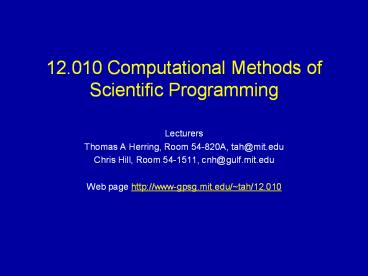12.010 Computational Methods of Scientific Programming - PowerPoint PPT Presentation
1 / 18
Title:
12.010 Computational Methods of Scientific Programming
Description:
12.010 Computational Methods of Scientific Programming – PowerPoint PPT presentation
Number of Views:44
Avg rating:3.0/5.0
Title: 12.010 Computational Methods of Scientific Programming
1
12.010 Computational Methods of Scientific
Programming
- Lecturers
- Thomas A Herring, Room 54-820A, tah_at_mit.edu
- Chris Hill, Room 54-1511, cnh_at_gulf.mit.edu
- Web page http//www-gpsg.mit.edu/tah/12.010
2
Summary
- Today we finish up C and start C
- Final C topics
- Structures A method for grouping like variables
together - Memory management
- Start of C
- History
- Ideas of classes and objects
- Examples to demonstrate concepts
3
Structures and Types
- Struct alone is still unclear - typedef
- typedef struct double cx
- double cy
- double cz t_point
- main()
- t_point point
- point.cx 3. point.cy3. point.cz2.
- plot(point)
4
Structures and Types
- Derived types just like basic types
- e.g. can use arrays
- typedef struct double cx
- double cy
- double cz t_point
- main()
- t_point point10 int i
- for (i0ilt10i)
- pointi.cx 3. pointi.cy3.
pointi.cz(double)i - for (i0ilt10i)
- plot(pointi)
5
Memory Management
- Application code creates variables and arrays at
runtime - ltstdlib.hgt - malloc, calloc, free, realloc
sizeof - e.g
- main(int argc, char argv)
- double foo int nel int i
- / Create an array of size nel at runtime /
- sscanf(argv1,d\n,nel)
- foo (double ) calloc(nel,sizeof(foo))
- if ( foo NULL ) exit(-1)
- for (i0iltneli) fooii
- free(foo)
6
Remember - ,
- short a short ptr_to_a
- a 1
- ptr_to_a a
- ptr_to_a 1
a
0001
0001
0002
0003
0x00
0xFF
a
foo (double ) calloc(3,sizeof(foo))
Here compiler allocated memory for you
Here application allocates memory
explicitly. Allows more control but
requires careful bookkeeping.
7
Towards C
- C essentials
- syntax v. fortran
- call by reference v. call by value
- pointers
- structure, typedef
- memory management
- C is also the basis for C
8
C
- Object Oriented - Allows you to build/compose v.
complex applications from building blocks - Appeared around 1984 (Bjarne Stroustrup, Bell
Labs) - ANSI standard 1997
- Syntax is like C. Getting started a few extra
keywords few new formalized concepts. - Book C The Core Language OReilly
- Successful because you can compose applications
from other peoples building blocks. Windows etc. - V. complex in detail, like Mathemetica takes many
years to learn everything!!
9
C concept
- C language classes
- Class is a formal way to think about good program
design. - Modularity, encapsulation, hierarchy, abstraction
- A class has
- Methods ( program logic)
- Data ( variables )
- can be private or public
- Example string
- Methods set, get
- Data string text, string length
10
C Basic Example
- main()
- String s
- printf("Executable code starting\n")
- s.set("Hello")
- printf("s\n",s.get())
- printf("Executable code ending\n")
- Compile using g
- Will write out hello some other stuff
11
C Basic Example
Class
- main()
- String s
- printf("Executable code starting\n")
- s.set("Hello")
- printf("s\n",s.get())
- printf("Executable code ending\n")
Instance of the Class
Methods
12
String Class - Behind the Scenes
- / Class interface definition /
- class String
- public
- String() / Constructor
/ - String() / Destructor
/ - void set(char s) / Set a string
/ - char get() / Get string value /
- private
- char str / Pointer to the
string / - int lngth / Length of the
string /
13
String Class Example Methods
- / Set str to point to a private copy of s /
- void Stringset(char s)
- lngth strlen(s)
- str new charlngth1
- strcpy(str, s)
- / Return the pointer to the string /
- char Stringget()
- return str
14
String Class Example Methods
- / Constructor /
- StringString()
- str 0
- set("")
- printf("I created a string\n")
- / Destructor /
- StringString()
- delete str
- printf("I deleted a string\n")
15
Application Example
Throwing a ball in the air
Get initial velocity and length of
experiment. Calculate time evolution of w and
z. Print out trajectory
z
w0
z0
16
C Procedural Form
- main ( )
- float t10. float w010.
- t_gball theBall/ Stats for the ball
/ - / Allocate space for full ball time history /
- createBall(w0, theBall )
- / Step forward the ball state /
- stepForwardState( t, theBall )
- / Write table of output /
- printTrajectory( t, w0, theBall)
17
C Using Ball Class
- main()
- float w0 10. float t10.
- Ball b
- b.initialize(w0)
- b.simulate(t)
- b.printTrajectory()
- All info. is held in b. Fewer args, cleaner
abstraction.
18
Summary
- Finished up C with structures and memory
management - Started with C
- C is C with the addition of classes
- Class is a formal way to think about good program
design. - Modularity, encapsulation, hierarchy, abstraction
- A class has
- Methods ( program logic)
- Data ( variables )
- can be private or public































